Analyzing Climate Change Awareness Campaigns: A Bibliometric Study of Scientific Research
Abstract
1. Introduction
1.1. Literature Review
1.2. Successful International Climate Change Campaigns
1.3. The Bibliometric Analysis
2. Materials and Methods
3. Results
3.1. Distribution of Document Types and the Impact of Top Contributors
3.2. Research Areas
3.3. Keyword Analysis
3.4. Environmental Sciences Ecology
- Scientific research and monitoring campaigns [76,77,78,79,80,81,82,83,84,85,86,87,88,89,90,91,92,93,94,95,96,97,98,99,100,101,102,103] (28 records). These campaigns focus on data collection, scientific research, or measurements in areas such as climate change, air quality, or other natural phenomena.
- Communication and social impact campaigns (3 records) [113,114,115]. These campaigns focus on public discourse, cultural narratives, and social transformation related to climate change, sustainability, and environmental policies. They analyze the role of media, communication strategies, and ideological messaging in shaping public engagement and influencing perceptions of climate issues.
3.5. Meteorology Atmospheric Sciences
- Atmospheric measurement and observation campaigns [85,86,102,116,117,118,119,120,121,122,123] (11 records). These studies focus on large-scale atmospheric observations to study weather patterns, air circulation, and interactions between land, ocean, and atmosphere. They often involve aircraft, satellite, or ground-based measurements to improve climate models and meteorological predictions.
- Climate communication and policy campaigns [49,56,78,99,134,135] (six records). These studies focus on public engagement, awareness, and policymaking related to climate change. They examine how people perceive climate risks, how clean energy initiatives can be framed for civic engagement, and how disaster preparedness campaigns can influence public behavior.
3.6. Science, Technology and Other Topics
- Sustainability and climate communication campaigns [26,70,108,136] (four records). These studies focus on the role of communication, public engagement, and digital tools in promoting sustainability, behavior change, and climate mitigation. They analyze how messaging, educational initiatives, and technological solutions can influence public perception and actions toward environmental sustainability.
- Political and social mobilization campaigns [137,138] (two records). These studies examine how campaigns drive political movements, grassroots activism, and public discourse on social and environmental issues. They explore the impact of mobilization efforts on policy, awareness, and societal change, often focusing on climate change or social justice topics.
- Experimental and technological field campaigns [63,139,140] (three records). These studies involve campaigns that test new technologies, tools, and methodologies in real-world settings. They focus on experimental approaches in environmental monitoring, sustainable infrastructure, and technological adoption to assess their effectiveness in practical applications.
4. Conclusions
Limitations of the Study
Author Contributions
Funding
Institutional Review Board Statement
Informed Consent Statement
Data Availability Statement
Conflicts of Interest
References
- Pachauri, R.K.; Mayer, L.; Intergovernmental Panel on Climate Change (Eds.) Climate Change 2014: Synthesis Report; Intergovernmental Panel on Climate Change: Geneva, Switzerland, 2015; ISBN 978-92-9169-143-2. [Google Scholar]
- Kaplan, S. Climate Change Affects Everything—Even the Coronavirus. The Washington Post, 15 April 2020. [Google Scholar]
- Waters, Y.L.; Wilson, K.A.; Dean, A.J. The Role of Iconic Places, Collective Efficacy, and Negative Emotions in Climate Change Communication. Environ. Sci. Policy 2024, 151, 103635. [Google Scholar] [CrossRef]
- Spence, A.; Poortinga, W.; Pidgeon, N. The Psychological Distance of Climate Change. Risk Anal. 2012, 32, 957–972. [Google Scholar] [CrossRef] [PubMed]
- Leiserowitz, A. Climate Change Risk Perception and Policy Preferences: The Role of Affect, Imagery, and Values. Clim. Change 2006, 77, 45–72. [Google Scholar] [CrossRef]
- Petersen, B.; Stuart, D.; Gunderson, R. Reconceptualizing Climate Change Denial: Ideological Denialism Misdiagnoses Climate Change and Limits Effective Action. Hum. Ecol. Rev. 2019, 25, 117–141. [Google Scholar] [CrossRef]
- Zein, M.R.A.; Fadillah, K.L.; Febriani, N.; Nasrullah, R.; Khang, N.T. Social Media Use for Climate Change Campaign among Indonesian Millennials. PRofesi Humas 2024, 8, 168–194. [Google Scholar] [CrossRef]
- Intergovernmental Panel on Climate Change (IPCC) (Ed.) Summary for Policymakers. In Global Warming of 1.5 °C; IPCC Special Report on Impacts of Global Warming of 1.5 °C Above Pre-Industrial Levels in Context of Strengthening Response to Climate Change, Sustainable Development, and Efforts to Eradicate Poverty; Cambridge University Press: Cambridge, UK, 2022; pp. 1–24. ISBN 978-1-009-15795-7. [Google Scholar]
- Den, E.M.; Kuramochi, T.; Höhne, N.; Cantzler, J.; Esmeijer, K.; Fekete, H.; Fransen, T.; Keramidas, K.; Roelfsema, M.; Sha, F.; et al. Are the G20 Economies Making Enough Progress to Meet Their NDC Targets? Energy Policy 2019, 126, 238–250. [Google Scholar] [CrossRef]
- Rogelj, J.; Popp, A.; Calvin, K.V.; Luderer, G.; Emmerling, J.; Gernaat, D.; Fujimori, S.; Strefler, J.; Hasegawa, T.; Marangoni, G.; et al. Scenarios towards Limiting Global-Mean Temperature Increase below 1.5 °C. Nat. Clim. Change 2018, 8, 325–332. [Google Scholar] [CrossRef]
- Nerlich, B.; Koteyko, N.; Brown, B. Theory and Language of Climate Change Communication. WIREs Clim. Change 2010, 1, 97–110. [Google Scholar] [CrossRef]
- Moser, S.C. Reflections on Climate Change Communication Research and Practice in the Second Decade of the 21st Century: What More Is There to Say? WIREs Clim. Change 2016, 7, 345–369. [Google Scholar] [CrossRef]
- Coyle, M. Understanding Resistance to Climate Change Resistance. Int. J. Aging Hum. Dev. 2014, 80, 76–86. [Google Scholar] [CrossRef]
- D’Angelo, P.; Lule, J.; Neuman, W.R.; Rodriguez, L.; Dimitrova, D.V.; Carragee, K.M. Beyond Framing: A Forum for Framing Researchers. J. Mass. Commun. Q. 2019, 96, 12–30. [Google Scholar] [CrossRef]
- Raducu, R.; Soare, C.; Chichirez, C.-M.; Purcarea, M.R. Climate Change and Social Campaigns. J. Med. Life 2020, 13, 454–457. [Google Scholar] [CrossRef]
- Doyle, J. Picturing the Clima(c)Tic: Greenpeace and the Representational Politics of Climate Change Communication. Sci. Cult. 2007, 16, 129–150. [Google Scholar] [CrossRef]
- Uggla, Y. Strategies to Create Risk Awareness and Legitimacy: The Swedish Climate Campaign. J. Risk Res. 2008, 11, 719–734. [Google Scholar] [CrossRef]
- Akil, H.; Robert-Demontrond, P.; Bouillé, J.; Hussein, S.; Zein, L. The Effect of Climate Change Semantic Expressions on Perceptions and Attitudes Towards Decarbonisation. Int. Bus. Res. 2018, 11, p92. [Google Scholar] [CrossRef]
- Masri, S.; Simolaris, A.; Hopfer, S.; Wu, J. Assessment of Climate Change Sentiment, Engagement and Adaptation through a Community-Based Outreach Campaign and Questionnaire across the United States. Earth 2020, 1, 75–96. [Google Scholar] [CrossRef]
- Holmberg, K.; Hellsten, I. Gender Differences in the Climate Change Communication on Twitter. Internet Res. 2015, 25, 811–828. [Google Scholar] [CrossRef]
- Fernandez, M.; Piccolo, L.; Alani, H.; Maynard, D.; Meili, C.; Wippoo, M. Pro-Environmental Campaigns via Social Media: Analysing Awareness and Behaviour Patterns. J. Web Sci. 2017, 3. [Google Scholar] [CrossRef]
- Howell, R.A. Investigating the Long-Term Impacts of Climate Change Communications on Individuals’ Attitudes and Behavior. Environ. Behav. 2014, 46, 70–101. [Google Scholar] [CrossRef]
- Manuti, A. Climate Change Awareness: An Explorative Study on the Discursive Construction of Ethical Consumption in a Communication Campaign. Am. J. Appl. Psychol. 2013, 1, 65–71. [Google Scholar] [CrossRef]
- Sanderson, M.; Doyle, H.; Walsh, P. Developing and Implementing a Targeted Health-Focused Climate Communications Campaign in Ontario-#MakeItBetter. Can. J. Public Health 2020, 111, 869–875. [Google Scholar] [CrossRef] [PubMed]
- Wynes, S.; Kotcher, J.; Donner, S.D. Can Citizen Pressure Influence Politicians’ Communication about Climate Change? Results from a Field Experiment. Clim. Change 2021, 168, 6. [Google Scholar] [CrossRef]
- Stein, L.; Michalke, A.; Gaugler, T.; Stoll-Kleemann, S. Sustainability Science Communication: Case Study of a True Cost Campaign in Germany. Sustainability 2024, 16, 3842. [Google Scholar] [CrossRef]
- Cernicova-Buca, M.; Dragomir, G.-M.; Gherheș, V.; Palea, A. Students’ Awareness Regarding Environment Protection in Campus Life: Evidence from Romania. Sustainability 2023, 15, 16444. [Google Scholar] [CrossRef]
- Gherheș, V.; Dragomir, G.-M.; Cernicova-Buca, M.; Palea, A. Enhancing Sustainability in University Campuses: A Study on Solid Waste Generation and Disposal Practices among Students in Politehnica University Timisoara, Romania. Sustainability 2024, 16, 6866. [Google Scholar] [CrossRef]
- European Environment Agency’s Home Page. Available online: https://www.eea.europa.eu/en (accessed on 22 March 2025).
- ACCEPT. ASEAN Climate Change and Energy Project (ACCEPT). Available online: https://accept.aseanenergy.org/ (accessed on 22 March 2025).
- Join the Biggest Hour for Earth|Earth Hour. Available online: https://www.earthhour.org/ (accessed on 22 March 2025).
- Fernandez, M.; Burel, G.; Alani, H.; Piccolo, S.G.; Meili, C.; Hess, R. Analysing Engagement towards the 2014 Earth Hour Campaign in Twitter. In EnviroInfo & ICT4S, Adjunct Proceedings; University of Copenhagen: Copenhagen, Denmark, 2015. [Google Scholar]
- Weaver, J. Like, Subscribe, Save the World: YouTubers Embrace Climate Activism, but Experts Question Reach and Motive. CBC News, 16 November 2019. [Google Scholar]
- Carter, N.; Childs, M. Friends of the Earth as a Policy Entrepreneur: ‘The Big Ask’ Campaign for a UK Climate Change Act. Environ. Politics 2018, 27, 994–1013. [Google Scholar] [CrossRef]
- de Moor, J.; De Vydt, M.; Uba, K.; Wahlström, M. New Kids on the Block: Taking Stock of the Recent Cycle of Climate Activism. Soc. Mov. Stud. 2021, 20, 619–625. [Google Scholar] [CrossRef]
- Nisbet, M.C.; Kotcher, J.E. A Two-Step Flow of Influence?: Opinion-Leader Campaigns on Climate Change. Sci. Commun. 2009, 30, 328–354. [Google Scholar] [CrossRef]
- Kim, H.; Armsworth, P.R.; Masuda, Y.J.; Chang, C.H. US-Based and International Environmental Nongovernmental Organizations Use Social Media, but Few Have Large Audiences Online. Conserv. Sci. Pract. 2024, 6, e13037. [Google Scholar] [CrossRef]
- Stop Offshore Drilling|Oceana. Available online: https://oceana.org/our-campaigns/climate-and-energy/ (accessed on 22 March 2025).
- Donthu, N.; Kumar, S.; Mukherjee, D.; Pandey, N.; Lim, W.M. How to Conduct a Bibliometric Analysis: An Overview and Guidelines. J. Bus. Res. 2021, 133, 285–296. [Google Scholar] [CrossRef]
- Wang, Q.; Su, M. Integrating Blockchain Technology into the Energy Sector—From Theory of Blockchain to Research and Application of Energy Blockchain. Comput. Sci. Rev. 2020, 37, 100275. [Google Scholar] [CrossRef]
- Sotoudeh-Anvari, A. A State-of-the-Art Review on D Number (2012–2022): A Scientometric Analysis. Eng. Appl. Artif. Intell. 2024, 127, 107309. [Google Scholar] [CrossRef]
- Dereli, T.; Baykasoglu, A.; Altun, K.; Durmusoglu, A.; Türksen, I.B. Industrial Applications of Type-2 Fuzzy Sets and Systems: A Concise Review. Comput. Ind. 2011, 62, 125–137. [Google Scholar] [CrossRef]
- Hassan, W.; Duarte, A.E. Bibliometric Analysis: A Few Suggestions. Curr. Probl. Cardiol. 2024, 49, 102640. [Google Scholar] [CrossRef] [PubMed]
- van Eck, N.J.; Waltman, L. Software Survey: VOSviewer, a Computer Program for Bibliometric Mapping. Scientometrics 2010, 84, 523–538. [Google Scholar] [CrossRef] [PubMed]
- Mackerle, J. FEM and BEM in the Context of Information Retrieval. Comput. Struct. 2002, 80, 1595–1604. [Google Scholar] [CrossRef]
- Bellis, N.D. Bibliometrics and Citation Analysis: From the Science Citation Index to Cybermetrics; Scarecrow Press: Lanham, MD, USA, 2009; ISBN 978-0-8108-6713-0. [Google Scholar]
- Chen, D.; Guo, Y.; Wang, C.; Xu, Y.; Zhang, H. Dispersion and Disparity: Bibliometric and Visualized Analysis of Research on Climate Change Science Communication. Int. J. Environ. Res. Public Health 2022, 19, 15766. [Google Scholar] [CrossRef]
- Ward, A. Running on Climate Change: Lessons Learned from the Campaign Trail. J. Clim. Change Health 2022, 7, 100163. [Google Scholar] [CrossRef]
- Ettinger, J.; McGivern, A.; Spiegel, M.P.; King, B.; Shawoo, Z.; Chapin, A.; Finnegan, W. Breaking the Climate Spiral of Silence: Lessons from a COP26 Climate Conversations Campaign. Clim. Change 2023, 176, 22. [Google Scholar] [CrossRef]
- Ekne, J. Focus on Climate Change Communication: The Climate Smart Campaign in Malmo (City of Malmo, Sweden). In Local Governments and Climate Change; Sustainable Energy Planning and Implementation in Small and Medium Sized Communities; Springer: Dordrecht, The Netherlands, 2010; Volume 39, pp. 345–355. [Google Scholar]
- Chabanet, P.; Stoica, G.; Carriere, S.M.; Sabinot, C.; Bedrossian, C.; Ferraris, J. Impact of the Use of a Teaching Toolbox in an Awareness Campaign on Children’s Representations of Coral Reefs. Front. Mar. Sci. 2018, 5, 340. [Google Scholar] [CrossRef]
- Heidbreder, L.M.; Lange, M.; Reese, G. #PlasticFreeJuly—Analyzing a Worldwide Campaign to Reduce Single-Use Plastic Consumption with Twitter. Environ. Commun. 2021, 15, 937–953. [Google Scholar]
- Wijaya, B.S.; Agustini, P.M.; Hanathasia, M.; Putri, D.M.; Sutawidjaya, A.H. Why Do People Ignore the ‘plastic Bag Diet’ Campaign? An Indonesian Consumers Perspective. In Proceedings of the 4th International Conference on Climate Change 2019 (4th ICCC 2019), Kuala Lumpur, Malaysia, 27–28 February 2020; Volume 423. [Google Scholar]
- Casado, F.; Hidalgo, M.C.; Garcia-Leiva, P. Energy Efficiency in Households: The Effectiveness of Different Types of Messages in Advertising Campaigns. J. Environ. Psychol. 2017, 53, 198–205. [Google Scholar] [CrossRef]
- Gulliver, R.; Chapman, C.M.; Solly, K.N.; Schultz, T. Testing the Impact of Images in Environmental Campaigns. J. Environ. Psychol. 2020, 71. [Google Scholar] [CrossRef]
- Hanus, N.; Wong-Parodi, G.; Hoyos, L.; Rauch, A. Framing Clean Energy Campaigns to Promote Civic Engagement among Parents. Environ. Res. Lett. 2018, 13, 034021. [Google Scholar] [CrossRef]
- Olausson, U. Making Sense of the Human-Nature Relationship A Reception Study of the “Nature Is Speaking” Campaign on YouTube. Nat. Cult. 2020, 15, 272–295. [Google Scholar] [CrossRef]
- Bain, M.; Soligo, D.; van der Werf, P.; Parizeau, K. The Limitations of an Informational Campaign to Reduce Household Food Waste at the Community Scale. Clean. Waste Syst. 2024, 9, 100167. [Google Scholar] [CrossRef]
- Vander Woude, T.M.; Shaw, B.R.; Oberhauser, K.S. Misgivings about Environmental Outreach as a Barrier in a Neighborhood Opinion Leader Campaign. Soc. Nat. Resour. 2024, 37, 919–939. [Google Scholar] [CrossRef]
- Gulliver, R.; Fielding, K.S.; Louis, W. Understanding the Outcomes of Climate Change Campaigns in the Australian Environmental Movement. Case Stud. Environ. 2019, 3, 1–9. [Google Scholar] [CrossRef]
- Sampei, Y.; Aoyagi-Usui, M. Mass-Media Coverage, Its Influence on Public Awareness of Climate-Change Issues, and Implications for Japan’s National Campaign to Reduce Greenhouse Gas Emissions. Glob. Environ. Change-Hum. Policy Dimens. 2009, 19, 203–212. [Google Scholar] [CrossRef]
- Billi, M.; Borquez, R.; Varela, J.C.; Aldunce, P.; Aspee, N.; Beauchamp, E.; Berrios, P.; Cuevas, M.; Loboguerrero, A.M.; Bustos, F.M.; et al. A Pioneering Approach to Measure Increased Resilience to Face Climate Change: Insights from the Race to Resilience Campaign. Environ. Res. Commun. 2024, 6, 095006. [Google Scholar] [CrossRef]
- Berger, S.; Ebeling, F.; Feldhaus, C.; Loeschel, A.; Wyss, A.M. What Motivates Smart Meter Adoption? Evidence from an Experimental Advertising Campaign in Germany. Energy Res. Soc. Sci. 2022, 85, 102357. [Google Scholar] [CrossRef]
- Schmid-Petri, H.; Reber, U.; Arlt, D.; Elgesem, D.; Adam, S.; Haussler, T. A Dynamic Perspective on Publics and Counterpublics: The Role of the Blogosphere in Pushing the Issue of Climate Change During the 2016 US Presidential Campaign. Environ. Commun. J. Nat. Cult. 2020, 14, 378–390. [Google Scholar] [CrossRef]
- Liao, Y.; Junco, P.R. Extreme Weather and the Politics of Climate Change: A Study of Campaign Finance and Elections. J. Environ. Econ. Manag. 2022, 111, 102550. [Google Scholar] [CrossRef]
- Wu, J. The Sword of Damocles: Understanding the Carbon Abatement Effects of Top-down Environmental Management Practices—Insights from China’s Campaign-Style Governance. J. Environ. Manag. 2024, 354, 120306. [Google Scholar]
- Meeks, L. Promising a Greener Paris: Anne Hidalgo’s Framing of Environmental Issues in Her Mayoral Campaigns. Environ. Commun. 2023, 17, 550–565. [Google Scholar] [CrossRef]
- Rootes, C. From Local Conflict to National Issue: When and How Environmental Campaigns Succeed in Transcending the Local. Environ. Politics 2013, 22, 95–114. [Google Scholar] [CrossRef]
- Katz-Kimchi, M.; Manosevitch, I. Mobilizing Facebook Users against Facebook’s Energy Policy: The Case of Greenpeace Unfriend Coal Campaign. Environ. Commun. 2015, 9, 248–267. [Google Scholar] [CrossRef]
- Hill, D.; Connelly, S. Community Energies: Exploring the Socio-Political Spatiality of Energy Transitions through the Clean Energy for Eternity Campaign in New South Wales Australia. Energy Res. Soc. Sci. 2018, 36, 138–145. [Google Scholar] [CrossRef]
- Boyer, A.-L.; Vaudor, L.; Le Lay, Y.-F.; Marty, P. Building Consensus? The Production of a Water Conservation Discourse Through Twitter: The Water Use It Wisely Campaign in Arizona. Environ. Commun. 2021, 15, 285–300. [Google Scholar] [CrossRef]
- Lervik, M.; Sutherland, C. Local Climate Governance in the Global South: The Case of eThekwini Municipality and the Responsible Accommodation Campaign. Environ. Policy Gov. 2017, 27, 325–335. [Google Scholar] [CrossRef]
- Kenfack, C.E. Saving Our “Common Home” Through Them: A Critical Analysis of the “For Our Common Home” Campaign in Alberta. Environ. Justice 2023, 16, 174–185. [Google Scholar] [CrossRef]
- Uusi-Rauva, C.; Heikkurinen, P. Overcoming Barriers to Successful Environmental Advocacy Campaigns in the Organizational Context. Environ. Commun. 2013, 7, 475–492. [Google Scholar] [CrossRef]
- Laestadius, L.I.; Neff, R.A.; Barry, C.L.; Frattaroli, S. “We Don’t Tell People What to Do”: An Examination of the Factors Influencing NGO Decisions to Campaign for Reduced Meat Consumption in Light of Climate Change. Glob. Environ. Change-Hum. Policy Dimens. 2014, 29, 32–40. [Google Scholar] [CrossRef]
- Shugart, H.; Macko, S.; Lesolle, P.; Szuba, T.; Mukelabai, M.; Dowty, P.; Swap, R. The SAFARI 2000—Kalahari Transect Wet Season Campaign of Year 2000. Glob. Change Biol. 2004, 10, 273–280. [Google Scholar] [CrossRef]
- Camps, A.; Munoz-Martin, J.F.; Perez, A.; Cardellach, E.; Ribo, S.; Pastena, M. FFSCAT Mission: Preliminary Results and Ice Products Validation with Mosaic Campaign Data. In Proceedings of the IGARSS 2020—2020 IEEE International Geoscience and Remote Sensing Symposium, Waikoloa, HI, USA, 26 September–2 October 2020; pp. 3341–3344. [Google Scholar]
- Schofield, R.; Avallone, L.M.; Kalnajs, L.E.; Hertzog, A.; Wohltmann, I.; Rex, M. First Quasi-Lagrangian in Situ Measurements of Antarctic Polar Springtime Ozone: Observed Ozone Loss Rates from the Concordiasi Long-Duration Balloon Campaign. Atmos. Chem. Phys. 2015, 15, 2463–2472. [Google Scholar] [CrossRef]
- Zografou, O.; Gini, M.; Fetfatzis, P.; Granakis, K.; Foskinis, R.; Manousakas, M.I.; Tsopelas, F.; Diapouli, E.; Dovrou, E.; Vasilakopoulou, C.N.; et al. High-Altitude Aerosol Chemical Characterization and Source Identification: Insights from the CALISHTO Campaign. Atmos. Chem. Phys. 2024, 24, 8911–8926. [Google Scholar] [CrossRef]
- Li, Z.; Li, C.; Ye, X.; Fu, H.; Wang, L.; Yang, X.; Wang, X.; Zhao, Z.; Kan, H.; Mellouki, A.; et al. Air Quality in the Middle and Lower Reaches of the Yangtze River Channel: A Cruise Campaign. Atmos. Chem. Phys. 2018, 18, 14445–14464. [Google Scholar] [CrossRef]
- Ferrero, L.; Cappelletti, D.; Busetto, M.; Mazzola, M.; Lupi, A.; Lanconelli, C.; Becagli, S.; Traversi, R.; Caiazzo, L.; Giardi, F.; et al. Vertical Profiles of Aerosol and Black Carbon in the Arctic: A Seasonal Phenomenology along 2 Years (2011–2012) of Field Campaigns. Atmos. Chem. Phys. 2016, 16, 12601–12629. [Google Scholar] [CrossRef]
- Farley, R.N.; Lee, J.E.; Rivellini, L.-H.; Lee, A.K.Y.; Dal Porto, R.; Cappa, C.D.; Gorkowski, K.; Shawon, A.S.M.; Benedict, K.B.; Aiken, A.C.; et al. Chemical Properties and Single-Particle Mixing State of Soot Aerosol in Houston during the TRACER Campaign. Atmos. Chem. Phys. 2024, 24, 3953–3971. [Google Scholar] [CrossRef]
- Guo, H.; Liu, J.; Froyd, K.D.; Roberts, J.M.; Veres, P.R.; Hayes, P.L.; Jimenez, J.L.; Nenes, A.; Weber, R.J. Fine Particle pH and Gas-Particle Phase Partitioning of Inorganic Species in Pasadena, California, during the 2010 CalNex Campaign. Atmos. Chem. Phys. 2017, 17, 5703–5719. [Google Scholar] [CrossRef]
- Friedrich, N.; Eger, P.; Shenolikar, J.; Sobanski, N.; Schuladen, J.; Dienhart, D.; Hottmann, B.; Tadic, I.; Fischer, H.; Martinez, M.; et al. Reactive Nitrogen around the Arabian Peninsula and in the Mediterranean Sea during the 2017 AQABA Ship Campaign. Atmos. Chem. Phys. 2021, 21, 7473–7498. [Google Scholar] [CrossRef]
- Hilario, M.R.A.; Crosbie, E.; Shook, M.; Reid, J.S.; Cambaliza, M.O.L.; Simpas, J.B.B.; Ziemba, L.; DiGangi, J.P.; Diskin, G.S.; Nguyen, P.; et al. Measurement Report: Long-Range Transport Patterns into the Tropical Northwest Pacific during the CAMP2Ex Aircraft Campaign: Chemical Composition, Size Distributions, and the Impact of Convection. Atmos. Chem. Phys. 2021, 21, 3777–3802. [Google Scholar] [CrossRef]
- Haywood, J.M.; Abel, S.J.; Barrett, P.A.; Bellouin, N.; Blyth, A.; Bower, K.N.; Brooks, M.; Carslaw, K.; Che, H.; Coe, H.; et al. The CLoud-Aerosol-Radiation Interaction and Forcing: Year 2017 (CLARIFY-2017) Measurement Campaign. Atmos. Chem. Phys. 2021, 21, 1049–1084. [Google Scholar] [CrossRef]
- Lim, S.; Lee, M.; Laj, P.; Kim, S.-W.; Ahn, K.-H.; Gil, J.; Shang, X.; Zanatta, M.; Kang, K.-S. Regional Characteristics of Fine Aerosol Mass Increase Elucidated from Long-Term Observations and KORUS-AQ Campaign at a Northeast Asian Background Site. Elem. Sci. Anthr. 2022, 10, 00020. [Google Scholar] [CrossRef]
- Kaskaoutis, D.G.; Pikridas, M.; Barmpounis, K.; Kassell, G.; Logan, D.; Rigler, M.; Ivancic, M.; Mohammadpour, K.; Mihalopoulos, N.; Lelieveld, J.; et al. Aerosol Characteristics and Types in the Marine Environments Surrounding the East Mediterranean- Middle East (EMME) Region during the AQABA Campaign. Atmos. Environ. 2023, 298, 119633. [Google Scholar] [CrossRef]
- Dickinson, G.N.; Miller, D.D.; Bajracharya, A.; Bruchard, W.; Durbin, T.A.; McGarry, J.K.P.; Moser, E.P.; Nunez, L.A.; Pukkila, E.J.; Scott, P.S.; et al. Health Risk Implications of Volatile Organic Compounds in Wildfire Smoke During the 2019 FIREX-AQ Campaign and Beyond. Geohealth 2022, 6, e2021GH000546. [Google Scholar] [CrossRef] [PubMed]
- Palacios, S.L.; Kudela, R.M.; Guild, L.S.; Negrey, K.H.; Torres-Perez, J.; Broughton, J. Remote Sensing of Phytoplankton Functional Types in the Coastal Ocean from the HyspIRI Preparatory Flight Campaign. Remote Sens. Environ. 2015, 167, 269–280. [Google Scholar] [CrossRef]
- Tadic, J.M.; Miller, S.; Yadav, V.; Biraud, S.C. Greenhouse Gas Fluxes from Alaska’s North Slope Inferred from the Airborne Carbon Measurements Campaign (ACME-V). Atmos. Environ. 2021, 248, 118239. [Google Scholar] [CrossRef]
- Papanikolaou, C.-A.; Papayannis, A.; Mylonaki, M.; Foskinis, R.; Kokkalis, P.; Liakakou, E.; Stavroulas, I.; Soupiona, O.; Hatzianastassiou, N.; Gavrouzou, M.; et al. Vertical Profiling of Fresh Biomass Burning Aerosol Optical Properties over the Greek Urban City of Ioannina, during the PANACEA Winter Campaign. Atmosphere 2022, 13, 94. [Google Scholar] [CrossRef]
- O’Shea, S.J.; Choularton, T.W.; Flynn, M.; Bower, K.N.; Gallagher, M.; Crosier, J.; Williams, P.; Crawford, I.; Fleming, Z.L.; Listowski, C.; et al. In Situ Measurements of Cloud Microphysics and Aerosol over Coastal Antarctica during the MAC Campaign. Atmos. Chem. Phys. 2017, 17, 13049–13070. [Google Scholar] [CrossRef]
- Sim, S.; Jeong, S.; Park, H.; Park, C.; Kwak, K.-H.; Lee, S.-B.; Kim, C.H.; Lee, S.; Chang, J.S.; Kang, H.; et al. Co-Benefit Potential of Urban CO2 and Air Quality Monitoring: A Study on the First Mobile Campaign and Building Monitoring Experiments in Seoul during the Winter. Atmos. Pollut. Res. 2020, 11, 1963–1970. [Google Scholar] [CrossRef]
- Deutscher, J.; Kupec, P.; Kucera, A.; Urban, J.; Ledesma, J.L.J.; Futter, M. Ecohydrological Consequences of Tree Removal in an Urban Park Evaluated Using Open Data, Free Software and a Minimalist Measuring Campaign. Sci. Total Environ. 2019, 655, 1495–1504. [Google Scholar] [CrossRef] [PubMed]
- Lonsdale, C.R.; Hegarty, J.D.; Cady-Pereira, K.E.; Alvarado, M.J.; Henze, D.K.; Turner, M.D.; Capps, S.L.; Nowak, J.B.; Neuman, A.; Middlebrook, A.M.; et al. Modeling the Diurnal Variability of Agricultural Ammonia in Bakersfield, California, during the CalNex Campaign. Atmos. Chem. Phys. 2017, 17, 2721–2739. [Google Scholar] [CrossRef]
- Huret, N.; Segonne, C.; Payan, S.; Salerno, G.; Catoire, V.; Ferrec, Y.; Roberts, T.; Fossi, A.P.; Rodriguez, D.; Croize, L.; et al. Infrared Hyperspectral and Ultraviolet Remote Measurements of Volcanic Gas Plume at MT Etna during IMAGETNA Campaign. Remote Sens. 2019, 11, 1175. [Google Scholar] [CrossRef]
- Tang, K.; Huang, Z.; Huang, J.; Maki, T.; Zhang, S.; Shimizu, A.; Ma, X.; Shi, J.; Bi, J.; Zhou, T.; et al. Characterization of Atmospheric Bioaerosols along the Transport Pathway of Asian Dust during the Dust-Bioaerosol 2016 Campaign. Atmos. Chem. Phys. 2018, 18, 7131–7148. [Google Scholar] [CrossRef]
- Khokhar, M.F.; Naveed, S.I.; Butt, J.K.; Abbas, Z. Comparative Analysis of Atmospheric Glyoxal Column Densities Retrieved from MAX-DOAS Observations in Pakistan and during MAD-CAT Field Campaign in Mainz, Germany. Atmosphere 2016, 7, 68. [Google Scholar] [CrossRef]
- Berberoglu, S.; Donmez, C.; Evrendilek, F. Coupling of Remote Sensing, Field Campaign, and Mechanistic and Empirical Modeling to Monitor Spatiotemporal Carbon Dynamics of a Mediterranean Watershed in a Changing Regional Climate. Environ. Monit. Assess. 2015, 187, 179. [Google Scholar] [CrossRef]
- Camilo Villegas, J.; Law, D.J.; Stark, S.C.; Minor, D.M.; Breshears, D.D.; Saleska, S.R.; Swann, A.L.S.; Garcia, E.S.; Bella, E.M.; Morton, J.M.; et al. Prototype Campaign Assessment of Disturbance-Induced Tree Loss Effects on Surface Properties for Atmospheric Modeling. Ecosphere 2017, 8, e01698. [Google Scholar] [CrossRef]
- Feldman, A.F.; Reed, S.; Amaral, C.; Babst-Kostecka, A.; Babst, F.; Biederman, J.; Devine, C.; Fu, Z.; Green, J.K.; Guo, J.; et al. Adaptation and Response in Drylands (ARID): Community Insights for Scoping a NASA Terrestrial Ecology Field Campaign in Drylands. Earths Future 2024, 12, e2024EF004811. [Google Scholar] [CrossRef]
- Mylonaki, M.; Papayannis, A.; Papanikolaou, C.-A.; Foskinis, R.; Soupiona, O.; Maroufidis, G.; Anagnou, D.; Kralli, E. Tropospheric Vertical Profiling of the Aerosol Backscatter Coefficient and the Particle Linear Depolarization Ratio for Different Aerosol Mixtures during the PANACEA Campaign in July 2019 at Volos, Greece. Atmos. Environ. 2021, 247, 118184. [Google Scholar] [CrossRef]
- Du, J.; Liu, J.C.-E.; Mix, T.L. China Deserves Its Hamburger: The Controversy over WildAid’s Shu Shi Campaign in China. Environ. Sociol. 2024, 10, 321–332. [Google Scholar] [CrossRef]
- Sassan, C.; Mahat, P.; Aronczyk, M.; Brulle, R.J. Energy Citizens “Just Like You”? Public Relations Campaigning by the Climate Change Counter-Movement. Environ. Commun. 2023, 17, 794–810. [Google Scholar] [CrossRef]
- Johnson, C.; Blackburn, S. Advocacy for Urban Resilience: UNISDR’s Making Cities Resilient Campaign. Environ. Urban. 2014, 26, 29–52. [Google Scholar] [CrossRef]
- Tang, Y.-T.; Chan, F.K.S.; O’Donnell, E.C.; Griffiths, J.; Lau, L.; Higgitt, D.L.; Thorne, C.R. Aligning Ancient and Modern Approaches to Sustainable Urban Water Management in China: Ningbo as a “Blue-Green City” in the “Sponge City” Campaign. J. Flood Risk Manag. 2018, 11, e12451. [Google Scholar] [CrossRef]
- Scheele, C.E. Green Web Applications as a Climate Change Mitigation Campaign Instruments. Energy Effic. 2015, 8, 759–771. [Google Scholar] [CrossRef]
- Barcan, R. The Campaign for Legal Personhood for the Great Barrier Reef: Finding Political and Pedagogical Value in a Spectacular Failure of Care. Environ. Plan. E-Nat. Space 2020, 3, 810–832. [Google Scholar] [CrossRef]
- Slocum, R. Consumer Citizens and the Cities for Climate Protection Campaign. Environ. Plan. A-Econ. Space 2004, 36, 763–782. [Google Scholar] [CrossRef]
- Freeman, C.P. Meat’s Place on the Campaign Menu: How US Environmental Discourse Negotiates Vegetarianism. Environ. Commun. 2010, 4, 255–276. [Google Scholar] [CrossRef]
- Muncie, E. Investing in Climate Solutions? An Exploration of the Discursive Power and Materiality of Fossil Fuel Divestment Campaigns in Scotland. J. Environ. Stud. Sci. 2021, 11, 537–547. [Google Scholar] [CrossRef]
- Almiron, N.; Khozyainova, N.; Freixes, L. “This Nagging Worry about the Carbon Dioxide Issue” Nuclear Denial and the Nuclear Renaissance Campaign. In Climate Change Denial Public Relations: Strategic Communication Interest. Groups In Climate Inaction; Routledge: London, UK, 2020; pp. 195–213. [Google Scholar]
- Gwiazdon, K.; Brown, D.A. The Climate Change Disinformation Campaign Attacking the Common Good, Advancing the Self, and Destroying Democracy. In Routledge Handbook Applied Climate Change Ethics; Routledge: London, UK, 2024; pp. 198–213. [Google Scholar]
- Brown, D.A. Norms for Scientific Claims Made in the Face of Scientific Uncertainty Lessons from the Climate Change Disinformation Campaign. In Earth Charter, Ecological Integrity Social Movements; Routledge: London, UK, 2014; pp. 50–60. [Google Scholar]
- Wendisch, M.; Poeschl, U.; Andreae, M.O.; Machado, L.A.T.; Albrecht, R.; Schlager, H.; Rosenfeld, D.; Martin, S.T.; Abdelmomonem, A.; Afchine, A.; et al. ACRIDICON-CHUVA CAMPAIGN Studying Tropical Deep Convective Clouds and Precipitation over Amazonia Using the New German Research Aircraft HALO. Bull. Am. Meteorol. Soc. 2016, 97, 1885–1908. [Google Scholar] [CrossRef]
- Wolf, B.; Chwala, C.; Fersch, B.; Garvelmann, J.; Junkermann, W.; Zeeman, M.J.; Angerer, A.; Adler, B.; Beck, C.; Brosy, C.; et al. THE SCALEX CAMPAIGN Scale-Crossing Land Surface and Boundary Layer Processes in the TERENO-preAlpine Observatory. Bull. Am. Meteorol. Soc. 2017, 98, 1217–1234. [Google Scholar] [CrossRef]
- Stephan, C.C.; Schnitt, S.; Schulz, H.; Bellenger, H.; de Szoeke, S.P.; Acquistapace, C.; Baier, K.; Dauhut, T.; Laxenaire, R.; Morfa-Avalos, Y.; et al. Ship- and Island-Based Atmospheric Soundings from the 2020 EUREC4A Field Campaign. Earth Syst. Sci. Data 2021, 13, 491–514. [Google Scholar] [CrossRef]
- Margitan, J.J.; Barnes, R.A.; Brothers, G.B.; Butler, J.; Burris, J.; Connor, B.J.; Ferrare, R.A.; Kerr, J.B.; Komhyr, W.D.; McCormick, M.P.; et al. Stratospheric Ozone Intercomparison Campaign (STOIC) 1989—Overview. J. Geophys. Res. Atmos. 1995, 100, 9193–9207. [Google Scholar] [CrossRef]
- Feldman, D.R.; Aiken, A.C.; Boos, W.R.; Carroll, R.W.H.; Chandrasekar, V.; Collis, S.; Creamean, J.M.; de Boer, G.; Deems, J.; Demott, P.J.; et al. The Surface Atmosphere Integrated Field Laboratory (SAIL) Campaign. Bull. Am. Meteorol. Soc. 2023, 104, E2192–E2222. [Google Scholar] [CrossRef]
- Ratnam, M.V.; Sunilkumar, S.V.; Parameswaran, K.; Murthy, B.V.K.; Ramkumar, G.; Rajeev, K.; Basha, G.; Babu, S.R.; Muhsin, M.; Mishra, M.K.; et al. Tropical Tropopause Dynamics (TTD) Campaigns over Indian Region: An Overview. J. Atmos. Sol. Terr. Phys. 2014, 121, 229–239. [Google Scholar] [CrossRef]
- Przybylak, R.; Arazny, A.; Nordli, O.; Finkelnburg, R.; Kejna, M.; Budzik, T.; Migala, K.; Sikora, S.; Puczko, D.; Rymer, K.; et al. Spatial Distribution of Air Temperature on Svalbard during 1 Year with Campaign Measurements. Int. J. Climatol. 2014, 34, 3702–3719. [Google Scholar] [CrossRef]
- Hartmann, C.; Moser-Reischl, A.; Rahman, M.A.; Franceschi, E.; von Strachwitz, M.; Pauleit, S.; Pretzsch, H.; Roetzer, T.; Paeth, H. The Footprint of Heat Waves and Dry Spells in the Urban Climate of Wurzburg, Germany, Deduced from a Continuous Measurement Campaign during the Anomalously Warm Years 2018–2020. Meteorol. Z. 2023, 32, 49–65. [Google Scholar] [CrossRef]
- Park, C.; Gerbig, C.; Newman, S.; Ahmadov, R.; Feng, S.; Gurney, K.R.; Carmichael, G.R.; Park, S.-Y.; Lee, H.-W.; Goulden, M.; et al. CO2 Transport, Variability, and Budget over the Southern California Air Basin Using the High-Resolution WRF-VPRM Model during the CalNex 2010 Campaign. J. Appl. Meteorol. Climatol. 2018, 57, 1337–1352. [Google Scholar] [CrossRef]
- Kim, S.-W.; McDonald, B.C.; Baidar, S.; Brown, S.S.; Dube, B.; Ferrare, R.A.; Frost, G.J.; Harley, R.A.; Holloway, J.S.; Lee, H.-J.; et al. Modeling the Weekly Cycle of NOx and CO Emissions and Their Impacts on O3 in the Los Angeles-South Coast Air Basin during the CalNex 2010 Field Campaign. J. Geophys. Res. Atmos. 2016, 121, 1340–1360. [Google Scholar] [CrossRef]
- Schiferl, L.D.; Heald, C.L.; Nowak, J.B.; Holloway, J.S.; Neuman, J.A.; Bahreini, R.; Pollack, I.B.; Ryerson, T.B.; Wiedinmyer, C.; Murphy, J.G. An Investigation of Ammonia and Inorganic Particulate Matter in California during the CalNex Campaign. J. Geophys. Res. Atmos. 2014, 119, 1883–1902. [Google Scholar] [CrossRef]
- Hayes, P.L.; Ortega, A.M.; Cubison, M.J.; Froyd, K.D.; Zhao, Y.; Cliff, S.S.; Hu, W.W.; Toohey, D.W.; Flynn, J.H.; Lefer, B.L.; et al. Organic Aerosol Composition and Sources in Pasadena, California, during the 2010 CalNex Campaign. J. Geophys. Res. Atmos. 2013, 118, 9233–9257. [Google Scholar] [CrossRef]
- Makarova, M.V.; Alberti, C.; Ionov, D.V.; Hase, F.; Foka, S.C.; Blumenstock, T.; Warneke, T.; Virolainen, Y.A.; Kostsov, V.S.; Frey, M.; et al. Emission Monitoring Mobile Experiment (EMME): An Overview and First Results of the St. Petersburg Megacity Campaign 2019. Atmos. Meas. Tech. 2021, 14, 1047–1073. [Google Scholar] [CrossRef]
- Wang, Y.; Pukite, J.; Wagner, T.; Donner, S.; Beirle, S.; Hilboll, A.; Vrekoussis, M.; Richter, A.; Apituley, A.; Piters, A.; et al. Vertical Profiles of Tropospheric Ozone From MAX-DOAS Measurements During the CINDI-2 Campaign: Part 1Development of a New Retrieval Algorithm. J. Geophys. Res. Atmos. 2018, 123, 10637–10670. [Google Scholar] [CrossRef]
- Pan, K.; Arellano, A.F.; Guo, Y.; Demoz, B. Investigating the Impact of Multiphysics on Modeled Planetary Boundary Layer Height Estimates during the PECAN Field Campaign. J. Appl. Meteorol. Climatol. 2024, 63, 1385–1407. [Google Scholar] [CrossRef]
- Hargreaves, K.; Fowler, D.; Pitcairn, C.; Aurela, M. Annual Methane Emission from Finnish Mires Estimated from Eddy Covariance Campaign Measurements. Theor. Appl. Climatol. 2001, 70, 203–213. [Google Scholar] [CrossRef]
- Melo, S.; Strong, K.; Bassford, M.; Preston, K.; McElroy, C.; Rozanov, E.; Egorova, T. Retrieval of Stratospheric NO2 Vertical Profiles from Ground-Based Zenith-Sky DOAS Measurements:: Results for the MANTRA 1998 Field Campaign. Atmos. Ocean 2005, 43, 339–350. [Google Scholar] [CrossRef]
- Girdwood, J.; Stanley, W.; Stopford, C.; Brus, D. Simulation and Field Campaign Evaluation of an Optical Particle Counter on a Fixed-Wing UAV. Atmos. Meas. Tech. 2022, 15, 2061–2076. [Google Scholar] [CrossRef]
- Kim, D.K.D.; Madison, T.P. Public Risk Perception Attitude and Information-Seeking Efficacy on Floods: A Formative Study for Disaster Preparation Campaigns and Policies. Int. J. Disaster Risk Sci. 2020, 11, 592–601. [Google Scholar] [CrossRef]
- Riviere, G.; Delanoe, J.; Doyle, J.D.; Methven, J.; Barrell, C.; Fearon, M.; Gray, S.; Johnson, A.; Jourdan, O.; Lachlan-Cope, T.; et al. The THINICE Field Campaign: Interactions between Arctic Cyclones, Tropopause Polar Vortices, Clouds, and Sea Ice in Summer. Bull. Am. Meteorol. Soc. 2024, 105, E2330–E2354. [Google Scholar] [CrossRef]
- Godfrey, D.M.; Feng, P. Communicating Sustainability: Student Perceptions of a Behavior Change Campaign. Int. J. Sustain. High. Educ. 2017, 18, 2–22. [Google Scholar] [CrossRef]
- Kintisch, E. Climate Change—Grassroots Effort Pays Dividends on Presidential Campaign Trail. Science 2007, 318, 1850–1851. [Google Scholar] [CrossRef] [PubMed]
- Li, R.; Yu, Y.; Chan, T.F. Motivational Discourse and Campaign-Style Mobilisation: A Positive Discourse Analysis of Language Poverty Alleviation Discourse in China. PLoS ONE 2023, 18, e0292834. [Google Scholar] [CrossRef] [PubMed]
- Rescic, S.; Mattone, M.; Fratini, F.; Luvidi, L. Conservation of Earthen Bricks in Architecture: An Experimental Campaign to Test Different Treatments on Vernacular Built Heritage. Heritage 2023, 6, 1541–1566. [Google Scholar] [CrossRef]
- Kraemer, R.; Remmler, P.; Bumberger, J.; Kabisch, N. Running a Dense Air Temperature Measurement Field Campaign at the Urban Neighbourhood Level: Protocol and Lessons Learned. MethodsX 2022, 9, 101719. [Google Scholar] [CrossRef]

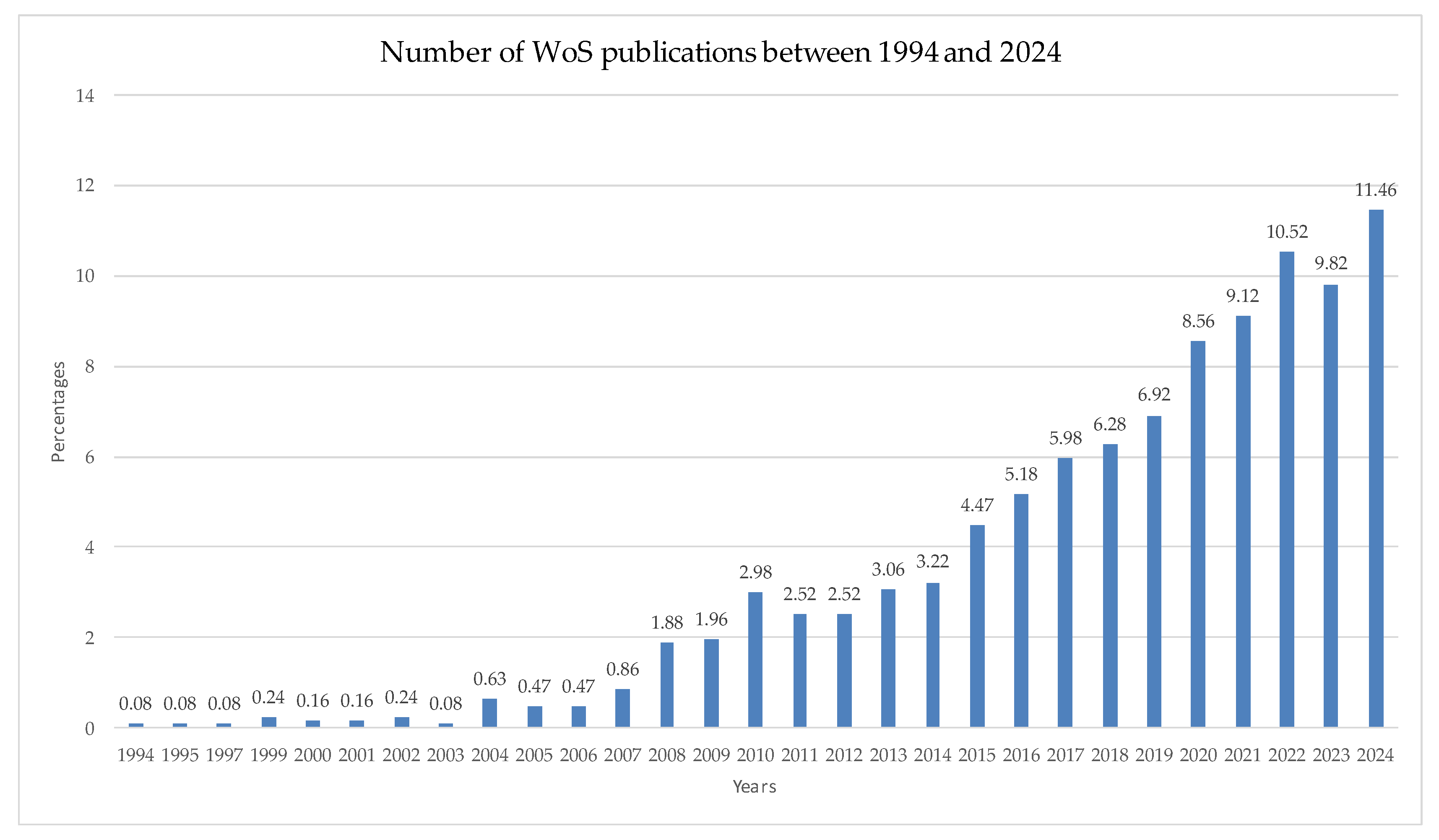

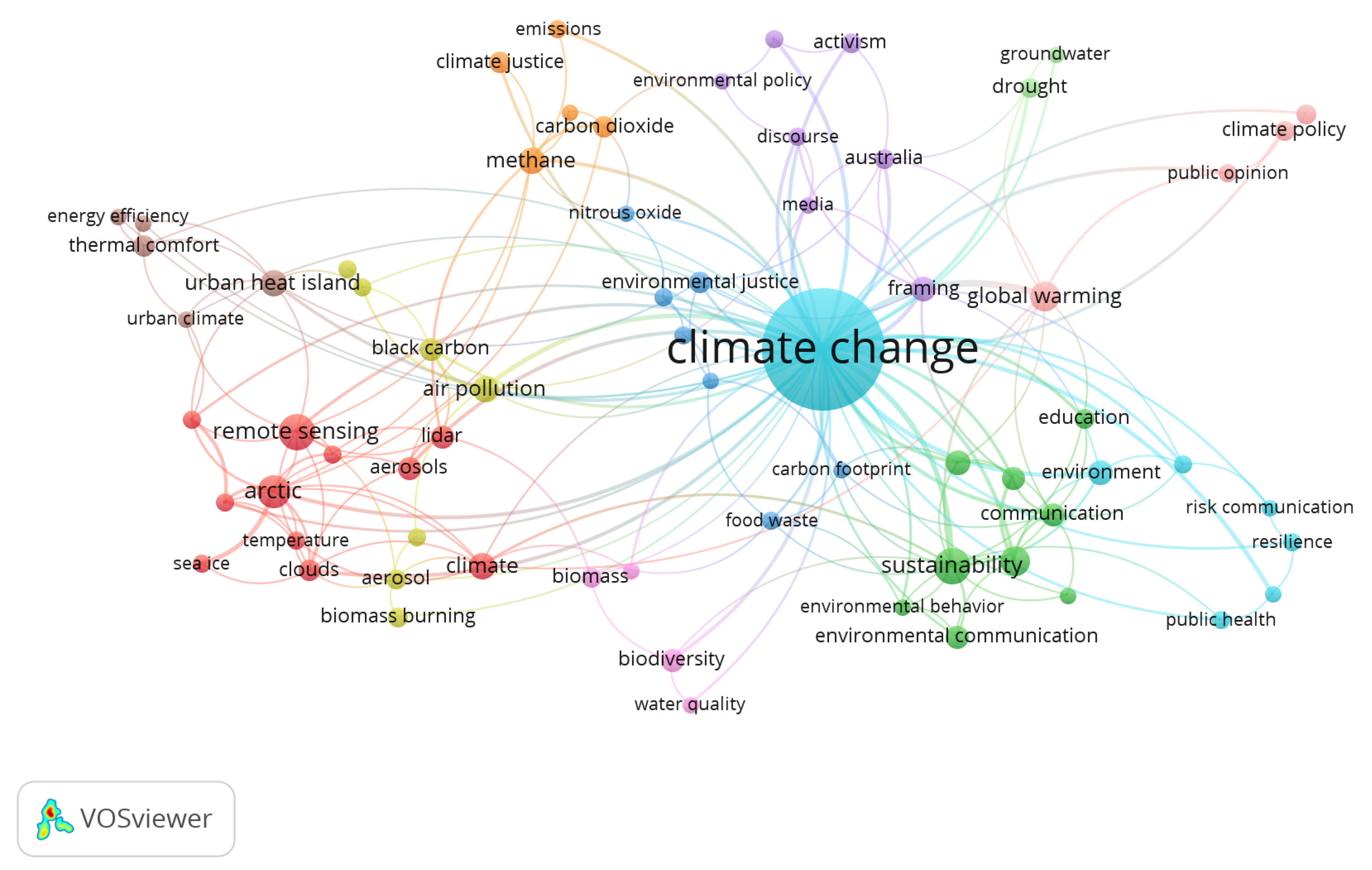
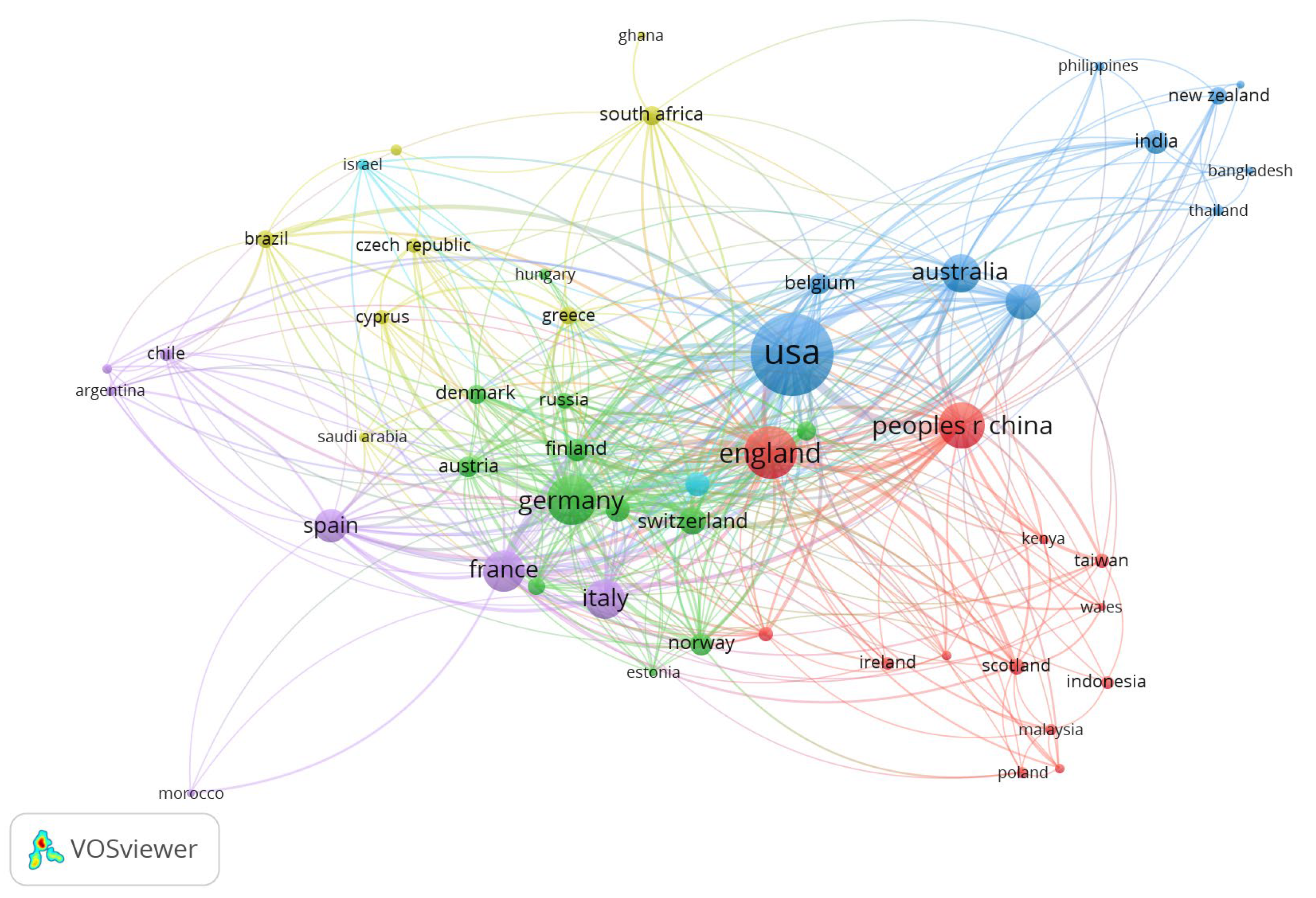

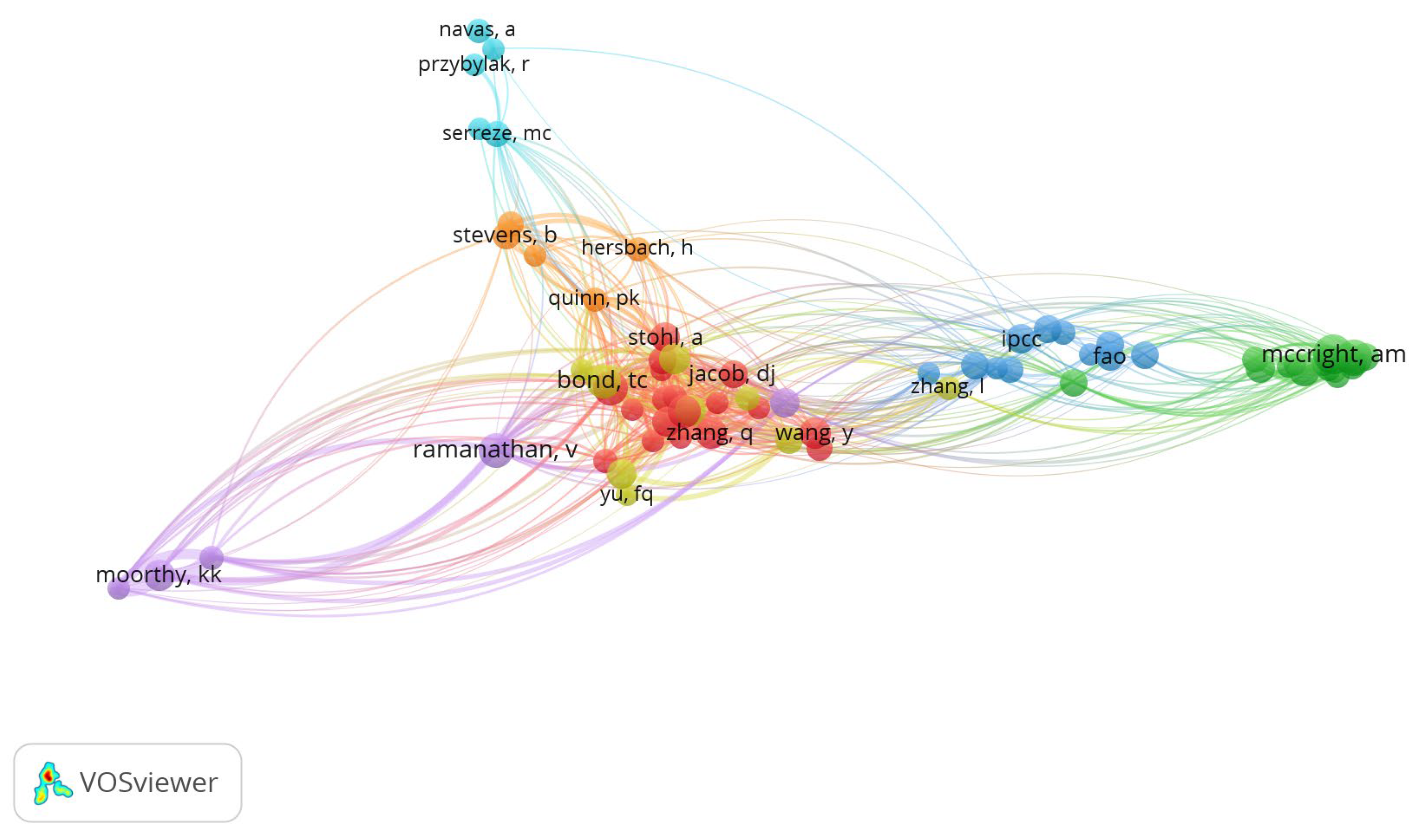
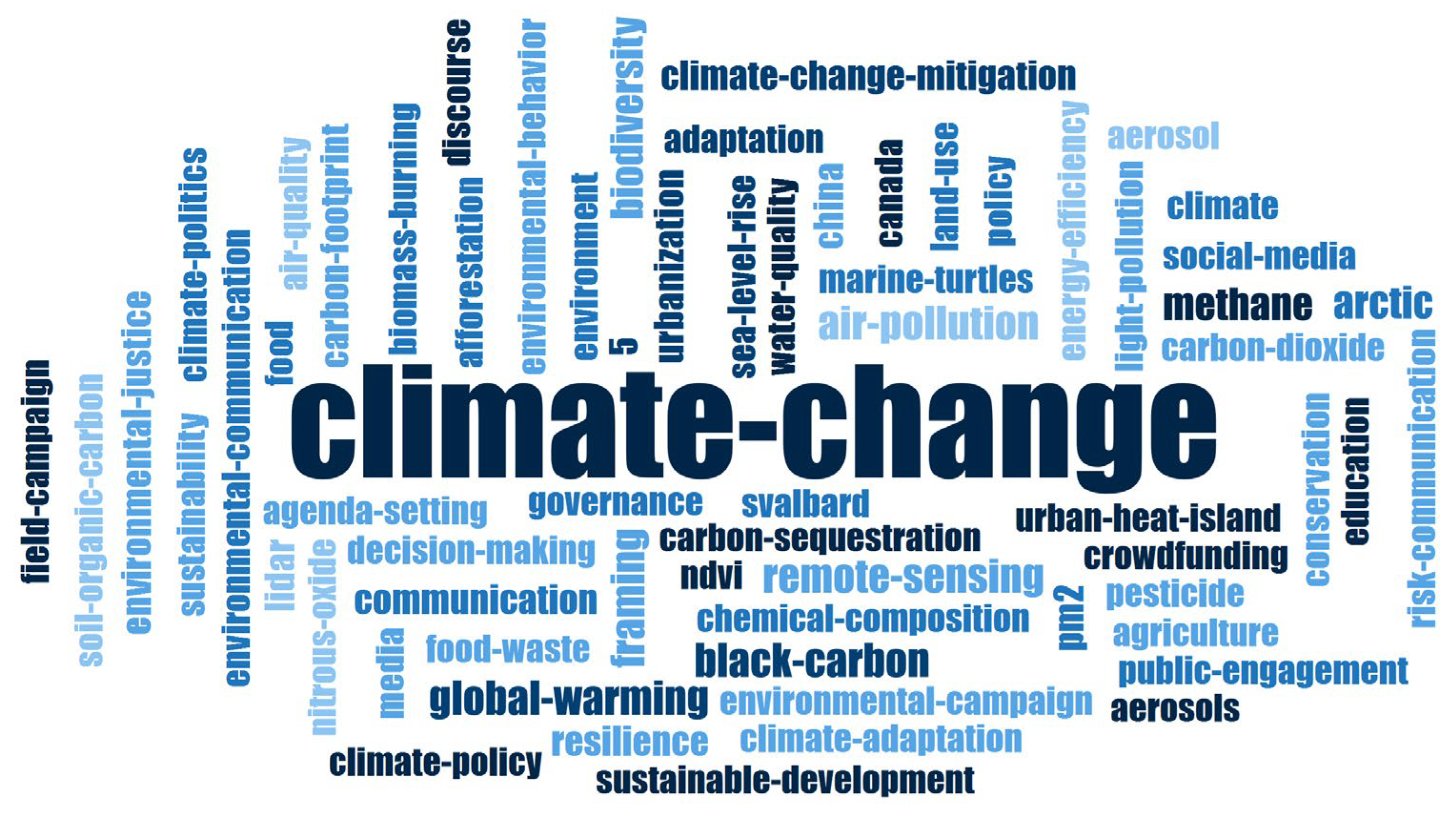

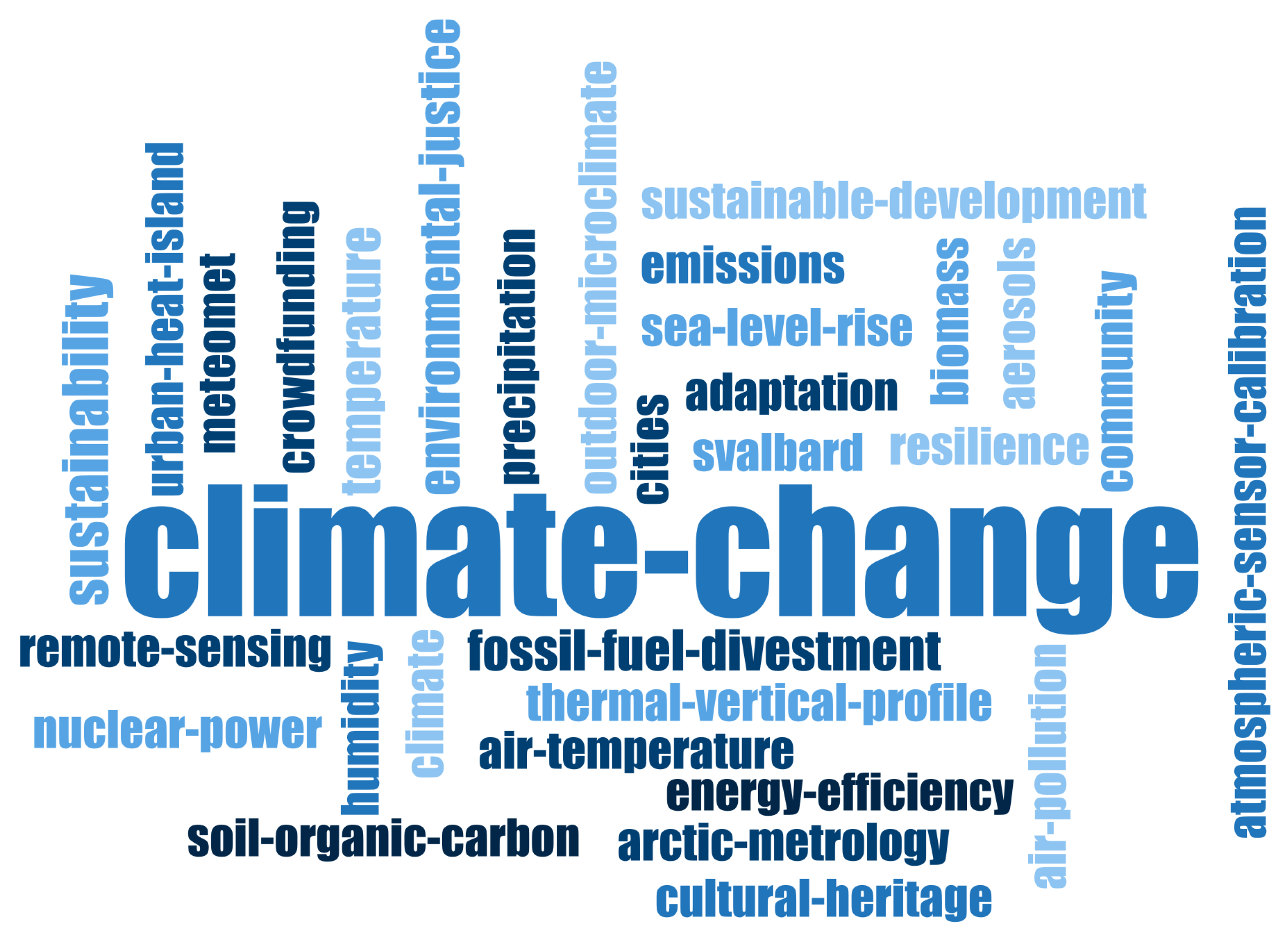
Disclaimer/Publisher’s Note: The statements, opinions and data contained in all publications are solely those of the individual author(s) and contributor(s) and not of MDPI and/or the editor(s). MDPI and/or the editor(s) disclaim responsibility for any injury to people or property resulting from any ideas, methods, instructions or products referred to in the content. |
© 2025 by the authors. Licensee MDPI, Basel, Switzerland. This article is an open access article distributed under the terms and conditions of the Creative Commons Attribution (CC BY) license (https://creativecommons.org/licenses/by/4.0/).
Share and Cite
Gherheș, V.; Coman, C.; Bucs, A.; Otovescu, A.; Bucs, L. Analyzing Climate Change Awareness Campaigns: A Bibliometric Study of Scientific Research. Sustainability 2025, 17, 3979. https://doi.org/10.3390/su17093979
Gherheș V, Coman C, Bucs A, Otovescu A, Bucs L. Analyzing Climate Change Awareness Campaigns: A Bibliometric Study of Scientific Research. Sustainability. 2025; 17(9):3979. https://doi.org/10.3390/su17093979
Chicago/Turabian StyleGherheș, Vasile, Claudiu Coman, Anna Bucs, Adrian Otovescu, and Loránt Bucs. 2025. "Analyzing Climate Change Awareness Campaigns: A Bibliometric Study of Scientific Research" Sustainability 17, no. 9: 3979. https://doi.org/10.3390/su17093979
APA StyleGherheș, V., Coman, C., Bucs, A., Otovescu, A., & Bucs, L. (2025). Analyzing Climate Change Awareness Campaigns: A Bibliometric Study of Scientific Research. Sustainability, 17(9), 3979. https://doi.org/10.3390/su17093979







